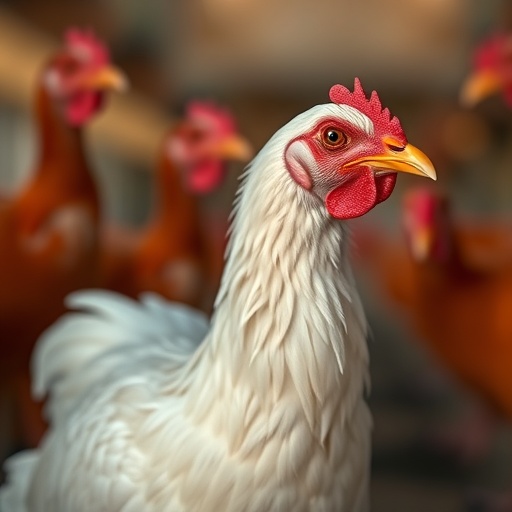
In a landmark nationwide study spanning four years, researchers have unveiled critical insights into the genetic landscape of avian influenza viruses (AIVs) circulating in live poultry markets throughout China, emphasizing the escalating threat posed by the H9N2 subtype. This comprehensive surveillance effort, initiated in 2014 and intensified between 2019 and 2023, analyzed over 18,000 poultry samples, revealing a significant 17.57% positivity rate for AIVs, with H9N2 emerging as the dominant viral lineage. The implications of these findings extend beyond veterinary health, underscoring an urgent zoonotic risk to human populations.
The vast surveillance network sampled a diverse range of poultry species, systematically collecting viral isolates that largely originated from live market environments—recognized hotspots for viral reassortment and propagation. Such markets act as critical interfaces where avian viruses encounter multiple hosts, facilitating genetic exchange and adaptation. The heightened detection of H9N2, overshadowing other AIV subtypes, spotlights this lineage’s remarkable fitness and evolutionary potential within these ecological niches.
Leveraging cutting-edge bioinformatics tools, the research team implemented an innovative automated phylogeny-based nomenclature system aimed at resolving the complex genetic relationships within the predominant H9N2 lineage, known as the BJ94 lineage. This system enabled the classification of distinct genetic clades with high precision, revealing the circulation of no fewer than ten unique haemagglutinin (HA) sub-subclades. Each sub-subclade exhibited subtle yet consequential antigenic variations, a factor that complicates vaccine design and disease management efforts due to differential immune escape phenotypes.
.adsslot_QoYp5EsJdf{width:728px !important;height:90px !important;}
@media(max-width:1199px){ .adsslot_QoYp5EsJdf{width:468px !important;height:60px !important;}
}
@media(max-width:767px){ .adsslot_QoYp5EsJdf{width:320px !important;height:50px !important;}
}
ADVERTISEMENT
Beyond delineating genetic diversity, the study probed critical molecular determinants linked to zoonotic transmission. Remarkably, over 99% of the H9N2 isolates collected between 2021 and 2023 harbored the HA-L226 mutation—a hallmark alteration within the haemagglutinin receptor-binding domain that confers increased affinity for human-type (α2,6-linked sialic acid) receptors. This adaptation suggests a concerted evolutionary trend toward enhanced human infectivity, which may facilitate cross-species transmission events.
Complementing this, approximately 96% of the viruses contained the NP-N52 mutation in the nucleoprotein gene, a modification previously implicated in resistance to human MxA antiviral proteins. MxA is a critical component of the innate immune response, acting as a potent inhibitor of viral replication in human cells. The co-occurrence of HA-L226 and NP-N52 mutations within the majority of recent H9N2 strains illustrates a dual adaptation: enhanced receptor binding alongside immune evasion, a combination that could significantly heighten the potential for zoonotic spillover and human-to-human transmission.
In vitro assays demonstrated that H9N2 viruses bearing the HA-L226 and NP-N52 mutations showed increased replication efficiency in human airway epithelial cell cultures, regardless of the presence or absence of PB2 mutations traditionally associated with mammalian adaptation, such as E627K. This finding challenges the paradigm that PB2 mutations are strictly necessary for efficient viral replication in mammals and suggests alternative evolutionary routes for avian influenza viruses to acquire human transmissibility traits.
The critical role of the PB2 protein mutations—particularly V/K/E627—cannot be discounted, however. Viruses combining HA-L226, PB2-V/K627, and NP-N52 mutations exhibited enhanced transmissibility in mammalian models, including direct contact and airborne droplet transmission among guinea pigs and ferrets. These species serve as well-established surrogates for studying influenza transmission dynamics pertinent to humans, underscoring the realistic threat that these genetically equipped H9N2 strains pose in a natural context.
The complexity of H9N2 genetics further encompasses antigenic variation among the co-circulating sub-subclades, presenting significant challenges for vaccine development. Antigenic drift within the haemagglutinin protein complicates immunogenic targeting, necessitating continuous viral genetic monitoring and updating of vaccine strains, similar to the approach taken for seasonal human influenza vaccines. This antigenic plasticity potentially facilitates viral persistence within poultry populations and enhances the viral reservoir for zoonotic transmission.
Live poultry markets, identified as hotspots for viral genetic exchange, accentuate the importance of targeted surveillance and control measures. Their role in maintaining and amplifying diverse viral populations elevates the risk of novel reassortant viruses emerging with pandemic potential. Consequently, there is a pressing need for integrative surveillance systems that combine real-time genetic analysis with epidemiological tracking to preempt zoonotic outbreaks.
The revelation that widely circulating H9N2 strains possess key molecular adaptations traditionally associated with human infectivity demands recalibration of public health risk assessments. Current avian influenza control policies focused predominantly on high-pathogenicity strains may underestimate the pandemic potential harbored by low-pathogenicity yet highly adaptable strains such as H9N2. This research advocates for an expanded surveillance scope that includes detailed functional characterization of viral mutations affecting host range and immune escape.
Moreover, the genetic signatures identified in these H9N2 viruses provide crucial molecular markers that could inform future diagnostic assays, enabling earlier detection of variants with enhanced zoonotic potential. Rapid molecular diagnostics integrated into live animal market monitoring could serve as frontline defenses against the unnoticed spread of high-risk strains, facilitating timely intervention.
The implications of these findings extend beyond China, given the global nature of poultry trade and migratory bird pathways that contribute to the dissemination of avian influenza viruses. International collaboration will be vital to track evolving viral genotypes and to coordinate preparedness strategies that address emergent zoonotic threats before they precipitate widespread human outbreaks.
This extensive survey and genetic characterization of H9N2 viruses represent a paradigm shift in understanding the subtle molecular evolution that primes avian infl uenza viruses for human infection. The study’s insights underscore the urgent need to reinforce One Health frameworks that integrate animal, environmental, and human health surveillance, research, and policy.
In conclusion, the increasing prevalence of H9N2 avian influenza viruses in domestic poultry reservoirs, coupled with convergent molecular adaptations enhancing human receptor binding and immune resistance, portend a heightened zoonotic threat. The articulation of distinct genetic clades exhibiting antigenic variation and the demonstration of transmissibility in mammalian models collectively underscore the pressing need for vigilant surveillance, targeted vaccine development, and robust public health preparedness to mitigate the risk of future influenza pandemics emanating from these evolving viruses.
Subject of Research: Genetic diversity and zoonotic transmission potential of H9N2 avian influenza viruses circulating in poultry across China.
Article Title: Genetic diversity of H9N2 avian influenza viruses in poultry across China and implications for zoonotic transmission.
Article References:
Yang, J., Li, J., Sun, J. et al. Genetic diversity of H9N2 avian influenza viruses in poultry across China and implications for zoonotic transmission.
Nat Microbiol (2025). https://doi.org/10.1038/s41564-025-02002-x
Image Credits: AI Generated
Tags: AIV surveillance in poultryavian influenza research findingsbioinformatics in virologygenetic diversity of avian virusesH9N2 avian influenza subtypeimplications for human healthlive poultry markets in Chinaphylogenetic analysis of H9N2poultry health and zoonotic diseasepoultry species and viral transmissionviral reassortment in live marketszoonotic risks of avian flu



